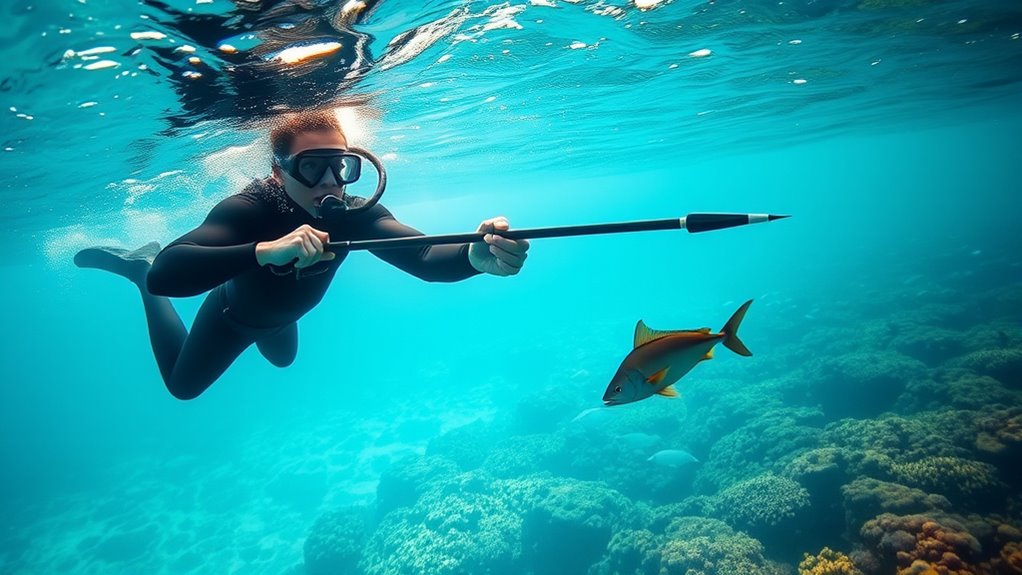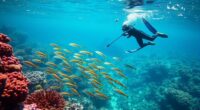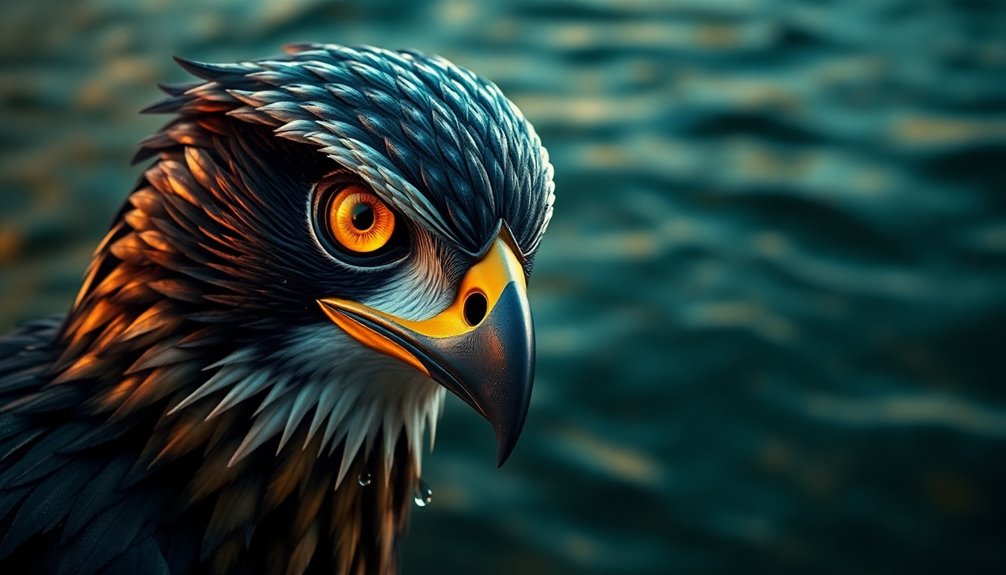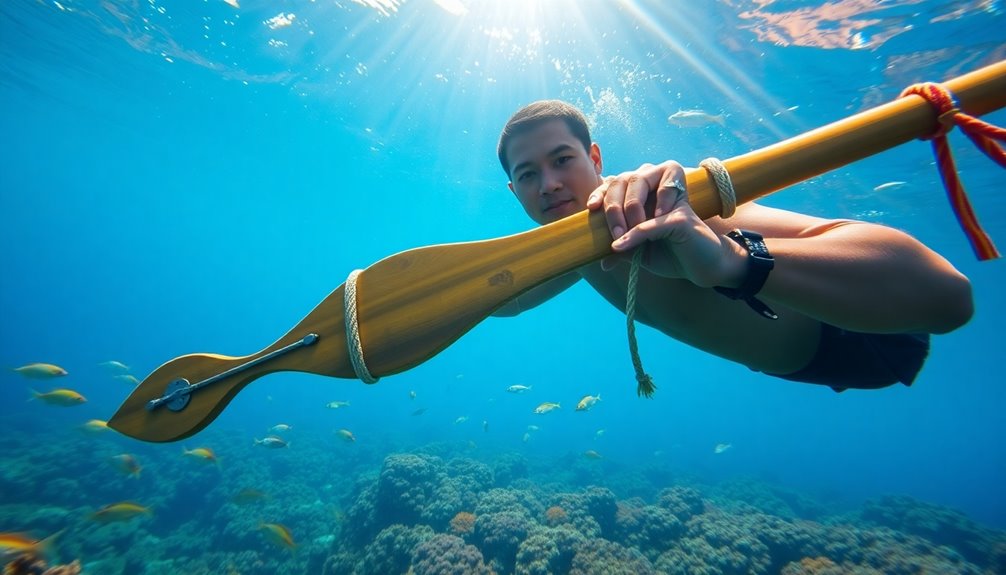To master advanced spearfishing techniques, focus on stealthy approaches like slow, deliberate movements, natural cover, and patient waiting. Use deep water tactics like splash-free dives and long guns for bottom hunting, while exploiting tidal currents and scent attractants to draw in fish. Practice precise maneuvering and safety protocols for challenging environments. If you keep exploring, you’ll discover even more refined strategies to enhance your effectiveness and guarantee sustainable, responsible fishing.
Key Takeaways
- Master stealth tactics like slow movements, natural cover, and controlled breathing to approach fish undetected.
- Utilize deep water and bottom hunting techniques, including splash-free dives and current exploitation for better target access.
- Incorporate scent trails, chumming, and decoys to attract and lure fish effectively in various environments.
- Enhance maneuverability with adjustable weights and safety gear to improve control and ensure safe, precise shots.
- Adapt approaches based on environmental cues, tide patterns, and fish behavior for increased success in advanced spearfishing.
Mastering Stealth and Patience in Ambush Hunting

To succeed in ambush spearfishing, you need to master stealth and patience. Move slowly and quietly, avoiding loud noises or sudden movements that could scare off your prey. Use natural cover like rocks, seaweed, or caves to blend in and stay concealed. Maintain a relaxed, still stance, holding your position for extended periods. Patience is key—resist the urge to chase or rush, allowing curious fish to approach within range naturally. Controlled breathing and proper body positioning help you stay motionless and calm. By focusing on remaining unseen and patient, you increase your chances of a successful shot. Remember, the goal is to be a part of the environment, not a disturbance, allowing ambush hunting to work in your favor.
Sinking Hunts: Techniques for Deep Water and Bottom Hunting
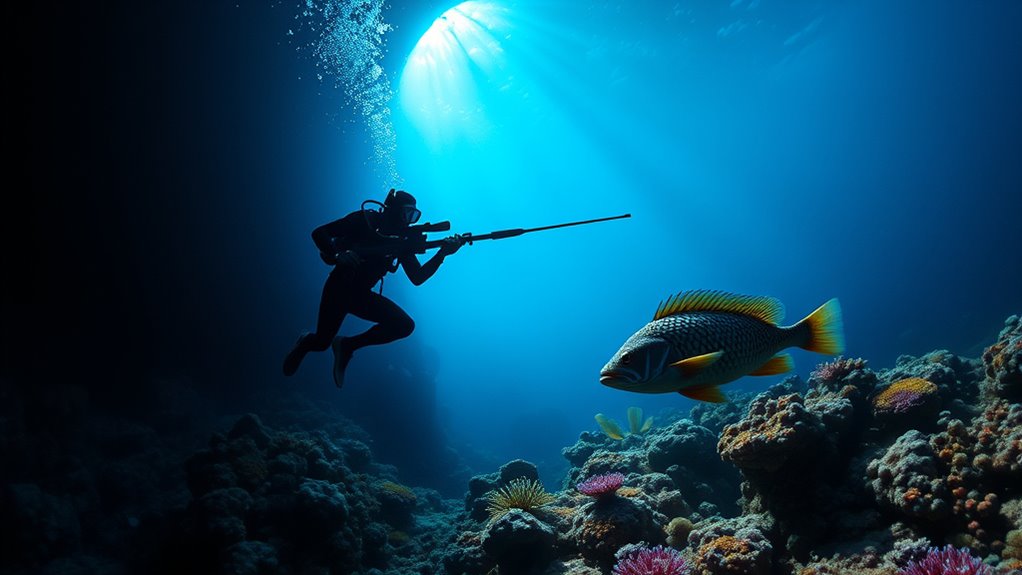
Sinking hunts demand a quiet, controlled descent that minimizes disturbance to the surrounding environment. To succeed in deep water and bottom hunting, you need to master precise, splash-free duck dives, allowing you to approach prey from beneath without alerting them. Use longer spearguns, around 90cm or more, to reach fish at greater depths and improve your chances of a clean shot. Your descent must be slow and deliberate, ensuring a stealth approach that keeps your presence unnoticed. Strong apnea skills are essential to hold your breath comfortably during these long, vertical approaches. By understanding current patterns and fish behavior at depth, you can better plan your stealthy approach, spotting targets from the surface or via binoculars before sinking down for the kill. Keeping your equipment streamlined and minimizing noise also enhances your stealth during these challenging hunts. Incorporating knowledge of automation in business can help you optimize your gear setup and timing, making your dives more efficient and effective. Additionally, mastering cost-effective strategies for gear maintenance ensures sustainability in your hunting practice. Being aware of soulmate angel numbers can also inspire patience and trust in your journey, both in life and in the water.
Effective Use of Bait and Attractants to Draw Large Fish
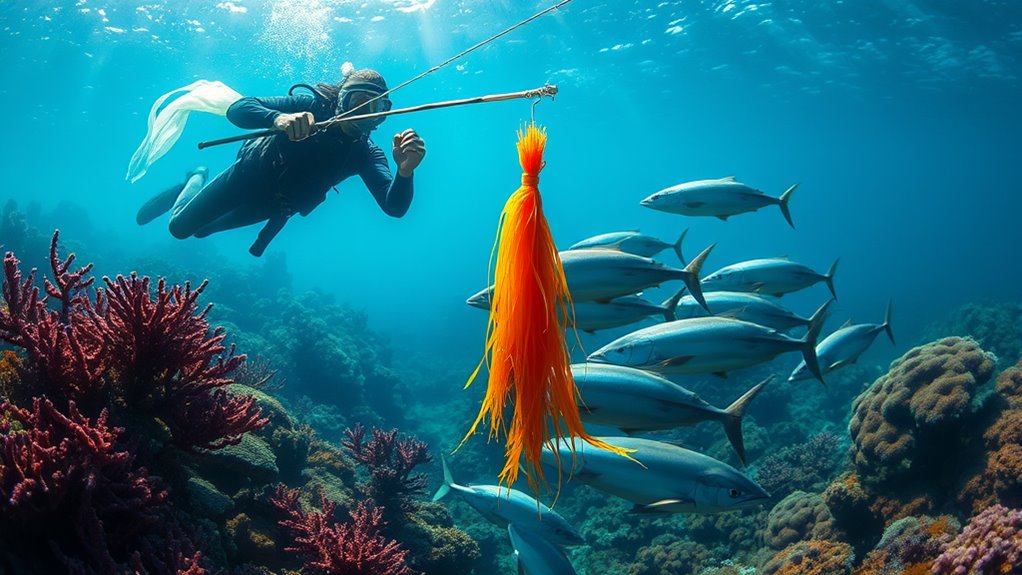
Using chumming with fresh baitfish creates a strong scent trail that signals nearby predators to feed. Adding visual attractants like flashers or reflective materials makes your setup more enticing and easier for fish to spot. Keep your bait and decoys well-placed and refreshed to maintain maximum attraction and increase your chances of a successful shot. Incorporating effective signaling techniques can further enhance your chances by making your bait more noticeable to large fish. Additionally, understanding fish behavior can help you time your baiting and chumming efforts for optimal results.
Chumming Strategies Effectiveness
Have you ever wondered why chumming is such an effective technique for attracting large predatory fish? When you use chumming, you release baitfish flesh and blood into the water, creating a powerful scent trail that triggers fish attraction. Properly managed, chumming can draw big game fish closer, especially in open waters. However, overdoing it or timing it poorly might attract sharks or unwanted predators, so understanding local fish behavior is key. Combining chumming with attractant techniques like flashers or metallic ribbons boosts your success. Regularly monitor and adjust your chumming intensity based on fish response to maintain an effective hunting zone. Additionally, understanding the local fish behavior can significantly improve your success rate by tailoring your techniques to specific species and conditions. Being aware of vetted practices ensures sustainable and responsible fishing, reducing the risk of disrupting the ecosystem. Here’s a quick overview:
| Chumming Technique | Fish Behavior Impact | Best Use Case |
|---|---|---|
| Baitfish release | Creates scent trail | Open water targeting |
| Timing adjustments | Maximizes attraction | Active feeding periods |
| Visual attractants | Enhances visibility | Deep or murky waters |
| Monitoring | Sustains effectiveness | Continuous improvement |
Visual Attractants and Decoys
Visual attractants and decoys play a crucial role in drawing large pelagic fish within striking range by stimulating their sight and curiosity. Using flashers with metallic ribbons, old lures, or plastic squid attached to a float creates powerful visual stimuli that attract fish from afar. Brightly colored or reflective decoys placed along the seabed mimic prey, enticing fish to approach. Combining these with scent attractants, such as chumming with cut baitfish or blood, enhances baiting effectiveness by engaging both sight and smell. Stirring up sand or silt near hiding spots simulates bait movement, drawing fish out of caves or crevices. Understanding tanning safety and proper skin care can help prevent skin damage from prolonged exposure to UV rays during outdoor activities. Additionally, using marine environment awareness techniques ensures that decoys and attractants do not disturb local ecosystems. Properly selecting appropriate decoy types can further improve visibility and attractiveness to target species. This strategic use of visual stimuli and scent attractants increases your chances of a successful shot and makes your spearfishing more efficient. Incorporating organization techniques like clear bins and designated zones can help keep your gear easily accessible and efficiently set up for quick deployment. Being mindful of sustainable fishing practices helps preserve marine life and ensures that fish populations remain healthy for future encounters.
Navigating and Exploiting Tidal Zones for Maximum Yield
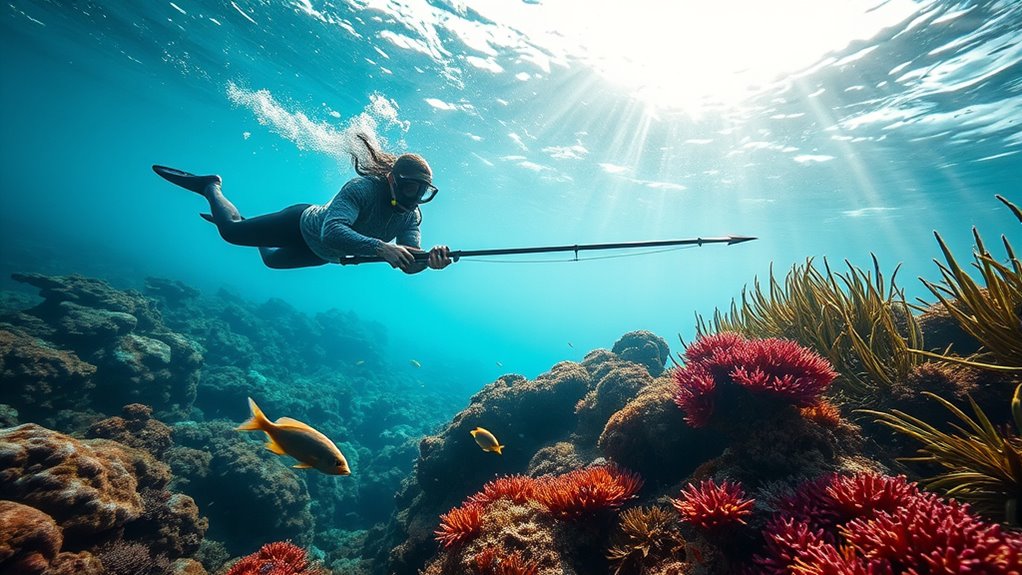
Timing your approach around tide changes maximizes fish activity in tidal zones. Use effective chumming to attract schools and increase your chances of a good shot. Be mindful of surge and currents, which can both present opportunities and pose safety risks. Incorporating knowledge of natural water movements can further enhance your success in locating and catching fish. Understanding the water flow patterns can help you predict fish behavior and optimize your positioning for better results. Monitoring signs of spoilage in bait and lures can also improve your chances of success during the hunt.
Timing and Tide Phases
Understanding the phases of the tide is crucial for maximizing your spearfishing success in tidal zones. Timing your dives around the tidal flow ensures you’re in the right place at the right moment. During flood and ebb tides, nutrient-rich waters attract schools of fish, boosting activity. Fish tend to feed actively and move into shallower areas during high tide, making these periods ideal for hunting. The strongest current occurs at mid-tide, so plan carefully to avoid dangerous conditions while still benefiting from increased visibility. During slack tide, fish often seek shelter, requiring patience and stealth. Use this table to grasp tidal phases and peak flow times:
| Phase | Current | Fish Activity |
|---|---|---|
| High Tide | Gentle slowing | Increased feeding, movement |
| Flood Tide | Rising peak | Active fish, good visibility |
| Ebb Tide | Falling peak | Fish retreating, less active |
| Slack Tide | Still water | Fish less active, sheltering |
Additionally, understanding tide charts can help you plan your dives more effectively by predicting tidal movements accurately. Knowing the precise current flow helps optimize your approach and increase your chances of success.
Effective Chumming Strategies
Maximizing your spearfishing yield in tidal zones requires more than just knowing when fish are active; it also depends on how effectively you attract them. Chumming is essential, especially during moving tides when currents carry the scent trail into feeding areas, boosting fish attraction. Use baitfish to release blood and flesh, creating a strong scent that guides predatory fish toward your ambush points, like rocks or seaweed beds. Always manage the amount and timing of bait release carefully to avoid attracting unwanted predators like sharks, ensuring safety and sustainability. In tidal zones, prioritize strategic positioning near natural ambush points, where fish are likely to gather. Proper chumming combined with awareness of tide movements maximizes your chances of a successful, safe, and productive hunt. Additionally, understanding the sound healing science behind natural vibrations can help you stay calm and focused during your dives, enhancing your overall effectiveness. Utilizing effective keto diet tracking methods can help maintain your energy levels and focus during demanding dives, ensuring you stay sharp and efficient in the water. Incorporating natural textures and materials into your gear setup can also improve your stealth and overall success during the hunt. Being aware of the expiration of vape juice can remind you to keep your gear in top condition and avoid distractions during critical moments. Moreover, paying attention to the essential oils for respiratory health can support clear breathing and endurance during long dives, increasing your overall performance.
Navigating Surge and Currents
Mastering movement and currents effectively can substantially boost your spearfishing success in tidal zones. Surge currents stir up the water, flushing out prey and concentrating fish in turbulence. To exploit these, study wave patterns and your local tide charts. Timing your dives during incoming or outgoing tides increases your chances of encountering active fish. Always follow safety precautions: wear heavy-duty gloves and wetsuits to handle strong wave bounces and avoid rocks washed into the surf zone. Use the table below to better understand surge behavior:
| Surge Type | Key Feature | Best Action | Safety Tip | When to Target |
|---|---|---|---|---|
| Tidal Surge | Driven by tide changes | Dive during peak surge | Watch for rocks and debris | During changing tides |
| Wave Patterns | Vary with wind and tide | Observe before diving | Stay alert for large waves | Before and after storms |
| Surge Intensity | Fluctuates with weather | Adjust dive depth accordingly | Use proper gear | Calm periods for safety |
| Current Exploitation | Fish are flushed into turbulence | Position yourself strategically | Secure gear to avoid loss | During surge peaks |
| Safety Precautions | Essential in turbulent zones | Always plan ahead | Know your limits | Always in surge zones |
Approaching Fish in Murky or Low-Visibility Conditions
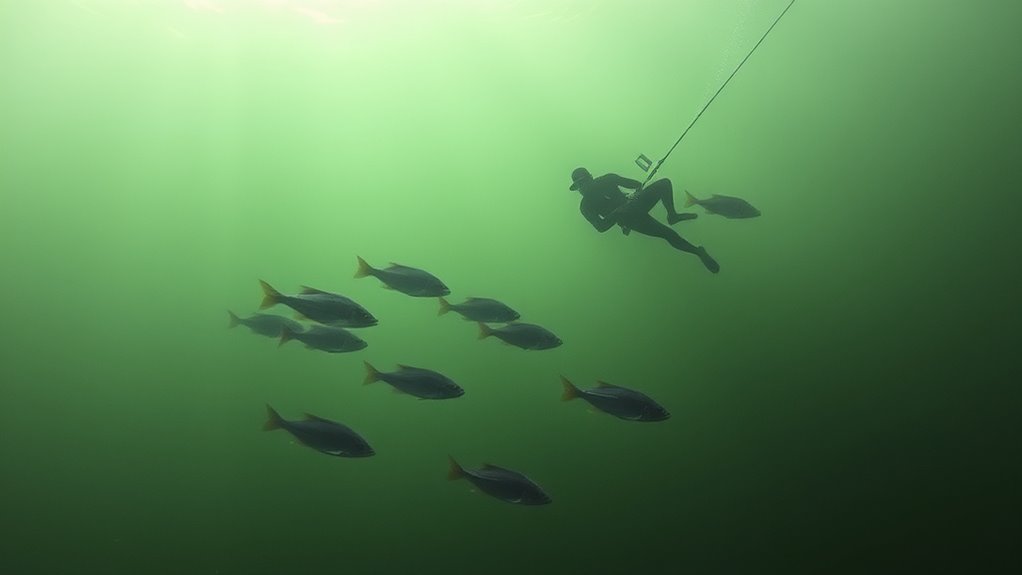
In low-visibility conditions, approaching fish requires patience and subtlety. You should use a flashlight or torch to identify hiding spots and attract fish without startling them. Gently stirring or disturbing the sand and silt creates movement that draws curious fish closer, making shots easier. Move slowly and deliberately, avoiding sudden movements or noise that could scare fish away in murky water. Pay close attention to fish behavior and sounds, like tail flicks or splashes, which signal nearby prey or predators. Use a shorter, heavier spear with screw-on tips to improve your accuracy and penetration in poor visibility. Your careful approach, combined with understanding fish behavior and controlled movement, enhances your chances of a successful shot under challenging conditions.
Combining Multiple Techniques for a Versatile Approach
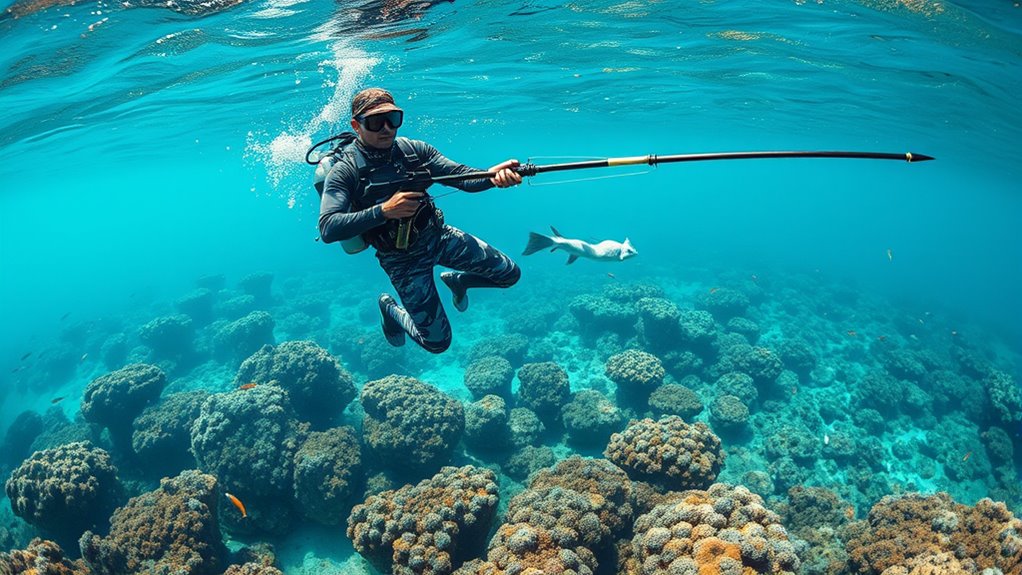
Combining multiple spearfishing techniques allows you to adapt to diverse underwater environments and target species more effectively. You can switch between ambush, hole hunting, and surface approaches by exploring crevices, waiting patiently, and approaching from different angles. Using stealth and controlled movements helps you transition smoothly between techniques, reducing fish alertness and increasing shot opportunities. Pay attention to environmental cues and fish behavior to select the best combination of methods based on site conditions and target species. Practice switching techniques fluidly—moving from passive waiting in ambush to actively probing hiding spots—so you stay flexible in changing scenarios. Technological tools like dive watches and flashers can help plan varied approaches, balancing safety, efficiency, and versatility in your overall strategy.
Handling and Retrieving Fish Safely and Efficiently
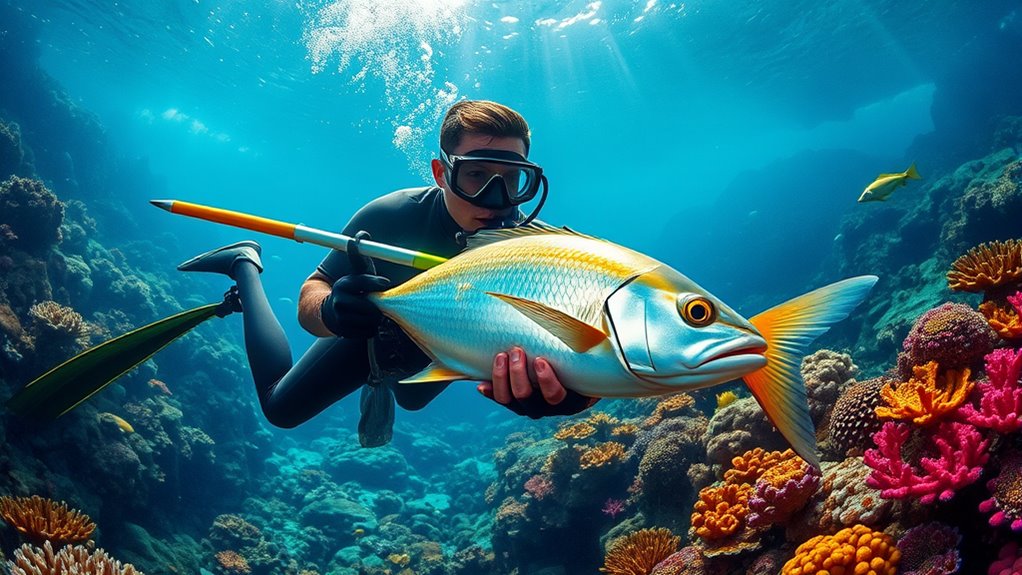
Handling and retrieving your catch safely and efficiently is essential to guarantee both your safety and the fish’s humane treatment. To do this, use a strong nylon line to attach your spear to the gun, ensuring a secure retrieval without the risk of losing the fish or gear. When you’ve shot a fish, grasp it firmly against your body, and use a sharp knife behind the eyes to humanely kill it quickly. Be cautious of predators like sharks or seals attracted to bleeding fish; stay alert and handle your catch promptly. For safe transport, weave or clip the fish onto a prong of your fish carrier or stringer, especially in rough conditions. Always prioritize handling and retrieving techniques that keep your safety and the fish’s humane treatment at the forefront.
Utilizing Specialized Equipment for Advanced Underwater Hunting

To enhance your underwater hunting capabilities, selecting and utilizing specialized equipment is essential. Reel guns and spear guns with integrated line reels help increase your range, power, and accuracy in deep or open water. Use line reels and swivels to manage long lines effectively, preventing tangles and ensuring quick shot retrieval. Choose gear made from corrosion-resistant materials like stainless steel or anodized aluminum to withstand saltwater exposure and improve longevity. A high-precision trigger mechanism allows for better shot accuracy, while heavy-duty spear tips (≥7mm) deliver more effective penetration, especially on larger or hidden fish. Additionally, incorporating advanced buoyancy equipment, such as adjustable weight systems or stabilizers, enhances your maneuverability and stability during complex dives, giving you greater control in challenging underwater environments.
Safety Strategies for Deep and Challenging Environments
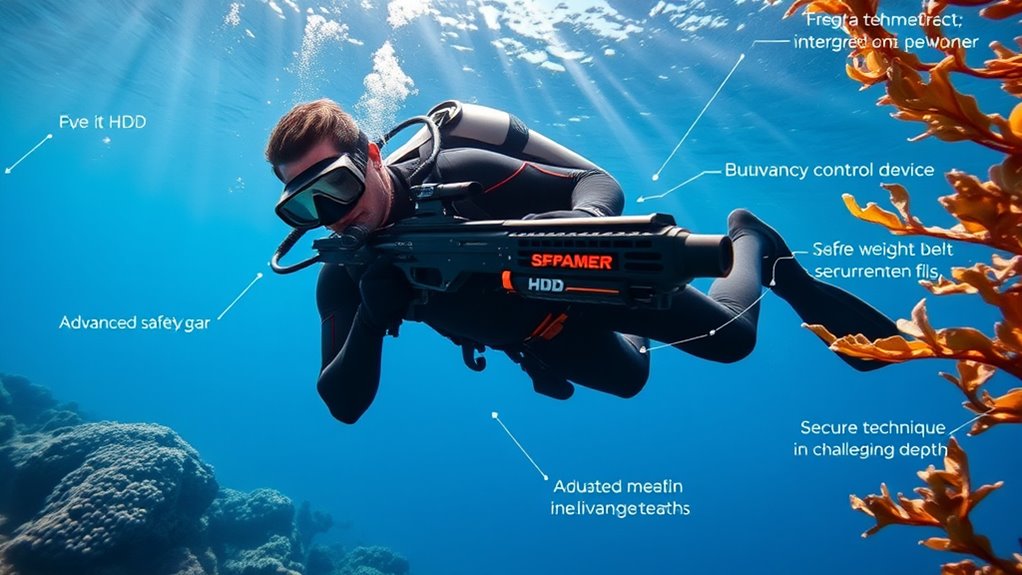
When venturing into deep or challenging underwater environments, you need to prioritize safety protocols. Always partner with a trained buddy and use communication signals to respond quickly to emergencies. Preparing for these conditions with proper equipment and gradual experience helps you stay safe and confident.
Deep Water Safety Protocols
Exploring deep water requires strict safety protocols to guarantee a secure experience. You must closely monitor your depth, use a dive computer or freediving watch, and stick to safe ascent rates. Always dive with a buddy to ensure immediate help if needed. Establish a clear communication plan and carry signaling devices like a whistle or surface marker buoy. Follow safety protocols that include a maximum depth, a predetermined surface interval, and a conservative approach to avoid decompression sickness. Prioritize proper equalization techniques and controlled ascents to prevent barotrauma and ensure safe decompression during deep dives. Remember, maintaining discipline in these protocols is essential for your safety and successful spearfishing in challenging environments.
Challenging Conditions Preparation
Preparing for challenging conditions requires more than just basic safety measures; it demands proactive strategies to handle the unpredictable nature of deep and rough waters. You should focus on mastering breath control and equalization techniques to stay calm and manage pressure at greater depths. Always dive with the right safety equipment, such as surface marker buoys, whistles, and waterproof communication devices, to alert others if needed. Depth training and consistent physical fitness are vital for handling demanding environments safely. Use a freediving watch with alarms to monitor ascent rates and prevent rapid ascents.
| Essential Safety Measures | Why It Matters |
|---|---|
| Breath control & equalization | Manage pressure & stay calm |
| Safety equipment | Alert others & coordinate rescue |
| Depth training & fitness | Build resilience & safety |
Ethical Practices and Conservation in Advanced Spearfishing
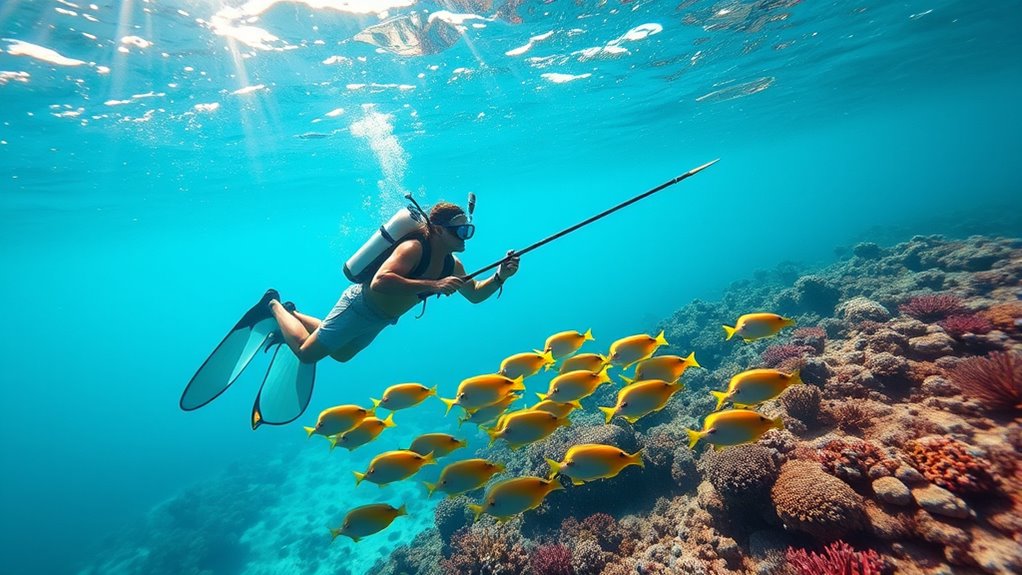
Practicing ethical spearfishing is essential to guarantee the health and sustainability of marine ecosystems. By following responsible harvesting, you help conserve fish populations and protect endangered species. Focus on sustainable spearfishing by targeting only legal-sized fish and avoiding protected or endangered species. Respect marine protected areas and seasonal restrictions by researching local regulations beforehand. Limit your catch per dive to prevent overfishing and maintain ecological balance. Use humane kills with proper shot placement to reduce fish suffering and promote healthy populations. Share your knowledge about responsible practices to raise awareness and foster conservation efforts.
Practice ethical spearfishing to protect marine life and promote sustainability through responsible harvesting and conservation efforts.
- Prioritize legal-sized fish and avoid protected species
- Use humane harvesting methods
- Limit your catch to prevent overfishing
- Respect marine protected areas and restrictions
Frequently Asked Questions
Why Is Spearfishing Illegal?
You might wonder why spearfishing is illegal in many places. It’s mainly because it can harm marine ecosystems by overharvesting fish and disrupting the balance. Authorities also want to protect vulnerable species and maintain biodiversity. Plus, safety concerns, like night spearfishing, lead to restrictions. By following these laws, you help preserve ocean life, prevent environmental damage, and avoid hefty fines or legal trouble.
What Are the Three Types of Spear Fishing?
You’re asking about the three main types of spearfishing. Surface hunting involves shooting fish from the water’s surface with pole spears or small guns, ideal for beginners. Ambush or stalking requires stealth, patience, and positioning near cover to wait for fish to come close. Hole or cave hunting focuses on targeting fish hiding in underwater crevices using flashlights and probing tools. Each method suits different skill levels and environments.
What Is the Best Key for Spearfishing?
The best key for spearfishing is mastering stealth and patience. You need to approach fish quietly, without startling them, and wait for the right moment to strike. Using high-quality gear, understanding fish behavior, and choosing the right environment all boost your success. Practice breath-hold techniques and dive smart. With these strategies, you’ll improve your chances of a successful catch and enjoy a more rewarding underwater experience.
What Is the Best Moon Phase for Spearfishing?
The best moon phase for spearfishing is during the new moon and full moon. These phases boost fish activity, making them easier to spot and catch. The full moon, with its bright night, helps you hunt nocturnal species, while the new moon’s darker skies reduce fish caution. Plus, spring tides around these phases create stronger currents that concentrate fish, increasing your chances of a successful hunt.
Conclusion
By mastering these advanced spearfishing techniques, you’ll elevate your hunting to legendary status, turning every plunge into a conquest of underwater mastery. With patience, stealth, and the right gear, you’ll outsmart even the cleverest fish in the deep blue. Remember, responsible practices protect these waters for generations to come. Dive confidently, respect the ocean, and transform yourself into a true underwater warrior—your skills will make the sea’s mysteries tremble before you.

